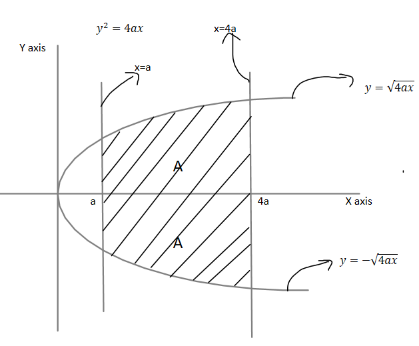
Area inside the parabola ${y^2} = 4ax$ between the lines $x = a\,\& \,x = 4a$ is equal to
$
a) \,4{a^2} \\
b) \,8{a^2} \\
c) \,\dfrac{{28}}{3}{a^2} \\
d) \,none\,of\,these \\
$
Answer
483.6k+ views
Hint: Area inside a parabola can be found using definite integration from $x = a\,to\,x = 4a$. As integration always gives area under the curve being represented. We have to integrate the function $y = f(x)$here $y = \sqrt {4ax} $
Area $ = \int\limits_a^{4a} {f(x)dx} $
Complete step-by-step answer:
Here, $y = \sqrt {4ax} $
Area $ = \int\limits_a^{4a} {f(x)dx} $
Area $ = \int\limits_a^{4a} {\sqrt {4ax} dx} $
Area $ = \sqrt {4a} \int\limits_a^{4a} {\sqrt x } dx$ { $\sqrt {4a}$ is a constant and can be taken out of integration}
$
= \sqrt {4a} \left[ {\dfrac{{{x^{\dfrac{1}{2} + 1}}}}{{\dfrac{1}{2} + 1}}} \right]_a^{4a} \\
= \sqrt {4a} \left[ {\dfrac{{{x^{\dfrac{3}{2}}}}}{{\dfrac{3}{2}}}} \right]_a^{4a} \\
= \dfrac{2}{3}\sqrt {4a} \left[ {{{\left( {4a} \right)}^{\dfrac{3}{2}}} - {{\left( a \right)}^{\dfrac{3}{2}}}} \right] \\
= \dfrac{2}{3}\sqrt {4a} \left[ {8{{\left( a \right)}^{\dfrac{3}{2}}} - {{\left( a \right)}^{\dfrac{3}{2}}}} \right] \\
= \dfrac{2}{3} \times 7{\left( a \right)^{\dfrac{3}{2}}} \times \sqrt {4a} \\
= \dfrac{{28}}{3}{a^{2\,}}\,\,sq\,units \\
$
Now this is the area of $y = + \sqrt {4ax}$ but not of $y = - \sqrt {4ax}$ which is also a solution of ${y^2} = 4ax$ therefore to find the solution of either we can integrate or we can conclude that by symmetry it is also equal to $ = \dfrac{{28}}{3}{a^{2\,}}\,\,sq\,units$
It can be clearly seen by the plot of ${y^2} = 4ax$

Total Area =$A + A = 2A$
Both graphs are symmetrical therefore total area equals to twice of area of $y = + \sqrt {4ax} $
So total area of ${y^2} = 4ax$ from $x = a\,to\,x = 4a$ is equal to $ = 2 \times \dfrac{{28}}{3}{a^{2\,}}\,\,sq\,units$$ = \dfrac{{56}}{3}{a^2}\,\,sq\,units$
So option D is correct.
Note: We have to take both $y = + \sqrt {4ax}$ and $y = - \sqrt {4ax}$ into consideration while always solving remember to simplify the equation to $y = f(x)$ as only it can be integrated don,t use ${y^2} = 4ax$ to be integrated. Use $y' = \sqrt {4ax}$ to be integrated. On parabola take symmetry into account along the respective axis. On integration area comes out to be negative we take the absolute value of area we can integrate $f(y) = \dfrac{{{y^2}}}{{4a}}$ to find the same solution but the procedure becomes lengthy and we don’t use this method.
Area $ = \int\limits_a^{4a} {f(x)dx} $
Complete step-by-step answer:
Here, $y = \sqrt {4ax} $
Area $ = \int\limits_a^{4a} {f(x)dx} $
Area $ = \int\limits_a^{4a} {\sqrt {4ax} dx} $
Area $ = \sqrt {4a} \int\limits_a^{4a} {\sqrt x } dx$ { $\sqrt {4a}$ is a constant and can be taken out of integration}
$
= \sqrt {4a} \left[ {\dfrac{{{x^{\dfrac{1}{2} + 1}}}}{{\dfrac{1}{2} + 1}}} \right]_a^{4a} \\
= \sqrt {4a} \left[ {\dfrac{{{x^{\dfrac{3}{2}}}}}{{\dfrac{3}{2}}}} \right]_a^{4a} \\
= \dfrac{2}{3}\sqrt {4a} \left[ {{{\left( {4a} \right)}^{\dfrac{3}{2}}} - {{\left( a \right)}^{\dfrac{3}{2}}}} \right] \\
= \dfrac{2}{3}\sqrt {4a} \left[ {8{{\left( a \right)}^{\dfrac{3}{2}}} - {{\left( a \right)}^{\dfrac{3}{2}}}} \right] \\
= \dfrac{2}{3} \times 7{\left( a \right)^{\dfrac{3}{2}}} \times \sqrt {4a} \\
= \dfrac{{28}}{3}{a^{2\,}}\,\,sq\,units \\
$
Now this is the area of $y = + \sqrt {4ax}$ but not of $y = - \sqrt {4ax}$ which is also a solution of ${y^2} = 4ax$ therefore to find the solution of either we can integrate or we can conclude that by symmetry it is also equal to $ = \dfrac{{28}}{3}{a^{2\,}}\,\,sq\,units$
It can be clearly seen by the plot of ${y^2} = 4ax$

Total Area =$A + A = 2A$
Both graphs are symmetrical therefore total area equals to twice of area of $y = + \sqrt {4ax} $
So total area of ${y^2} = 4ax$ from $x = a\,to\,x = 4a$ is equal to $ = 2 \times \dfrac{{28}}{3}{a^{2\,}}\,\,sq\,units$$ = \dfrac{{56}}{3}{a^2}\,\,sq\,units$
So option D is correct.
Note: We have to take both $y = + \sqrt {4ax}$ and $y = - \sqrt {4ax}$ into consideration while always solving remember to simplify the equation to $y = f(x)$ as only it can be integrated don,t use ${y^2} = 4ax$ to be integrated. Use $y' = \sqrt {4ax}$ to be integrated. On parabola take symmetry into account along the respective axis. On integration area comes out to be negative we take the absolute value of area we can integrate $f(y) = \dfrac{{{y^2}}}{{4a}}$ to find the same solution but the procedure becomes lengthy and we don’t use this method.
Recently Updated Pages
Master Class 12 Economics: Engaging Questions & Answers for Success

Master Class 12 Maths: Engaging Questions & Answers for Success

Master Class 12 Biology: Engaging Questions & Answers for Success

Master Class 12 Physics: Engaging Questions & Answers for Success

Master Class 12 Business Studies: Engaging Questions & Answers for Success

Master Class 12 English: Engaging Questions & Answers for Success

Trending doubts
Which are the Top 10 Largest Countries of the World?

Differentiate between homogeneous and heterogeneous class 12 chemistry CBSE

Draw a labelled sketch of the human eye class 12 physics CBSE

What is a transformer Explain the principle construction class 12 physics CBSE

What are the major means of transport Explain each class 12 social science CBSE

What is the Full Form of PVC, PET, HDPE, LDPE, PP and PS ?




